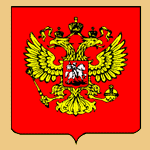 Russia
is a vast country with a wealth of natural resources, a well-educated
population and a diverse industrial base. Russia
is a vast country with a wealth of natural resources, a well-educated
population and a diverse industrial base.
Russia is the largest country in the world. It can be
divided into two main parts - western and eastern - roughly
along the line of the Yenisey River. It's situated in the Eastern
part of Europe and Northern part of Asia. The territory of Russia
spans through 11 times zones.
|
 Officially
called the Russian Federation; historically the term is used
to refer to the Russian Empire (862-1917), which covered a much
larger area than that of present-day Russia. From 1922 until
December 25, 1991, the Russian Federation formed part of the
Union of Soviet Socialist Republics (USSR; or Soviet Union).
The term Russian Federation (or RSFSR), however, originally
applied to the state proclaimed by the Bolsheviks in October
1917 as the territorial successor to the whole of the Russian
Empire. Officially
called the Russian Federation; historically the term is used
to refer to the Russian Empire (862-1917), which covered a much
larger area than that of present-day Russia. From 1922 until
December 25, 1991, the Russian Federation formed part of the
Union of Soviet Socialist Republics (USSR; or Soviet Union).
The term Russian Federation (or RSFSR), however, originally
applied to the state proclaimed by the Bolsheviks in October
1917 as the territorial successor to the whole of the Russian
Empire.
|
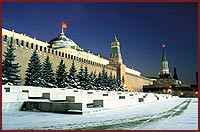 It
was only on the formation of the Soviet Union in 1922, following
the decision by the Bolsheviks to respect the self-determination
of the empire's many nations, that the Russian Federation became
one of the USSR's 15 constitutional republics-albeit the largest
and most influential, accounting for more than three quarters
of its area and more than half of its population. It
was only on the formation of the Soviet Union in 1922, following
the decision by the Bolsheviks to respect the self-determination
of the empire's many nations, that the Russian Federation became
one of the USSR's 15 constitutional republics-albeit the largest
and most influential, accounting for more than three quarters
of its area and more than half of its population.
|
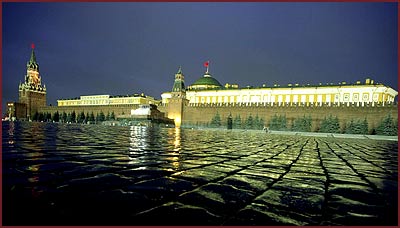
Moscow, view of Kremlin, Red Square
and Lenin Mausoleum.
The current Constitution was adopted 12 December 1993
by national referendum.
The national capital is Moscow.
The chief of the state - President, elected by popular
vote for a four-year term. Current president is Vladimir
Putin (since March 2000).
The legislative branch is Federal Assembly, which consists
of State Duma and the Federation Council (Sovet Federatzii).
The executive branch is run by the government. The head of the
government is appointed by the president with approval of the
State Duma.
|
 The
climate of Russia varies from the steppes in the south and coastal
on the north-west through humid continental in much of European
Russia; sub arctic in Siberia to tundra climate in the polar
north and monsoon on the Far East. The average temperatures
of January vary from 0 to -50°C, July - from 1 to 25°C.
Many regions of Siberia and Far East are situated in the permafrost
zone. Thus, Russia is one of the coldest countries in the world.
The town of Oimyakon in north-east Siberia is the coldest
inhabited place on earth, with temperatures recorded at more
than 70°C below zero. The inhabited areas are mostly
in the continental climate zones with long freezing winters
(5-6 months long) and short warm summers. The
climate of Russia varies from the steppes in the south and coastal
on the north-west through humid continental in much of European
Russia; sub arctic in Siberia to tundra climate in the polar
north and monsoon on the Far East. The average temperatures
of January vary from 0 to -50°C, July - from 1 to 25°C.
Many regions of Siberia and Far East are situated in the permafrost
zone. Thus, Russia is one of the coldest countries in the world.
The town of Oimyakon in north-east Siberia is the coldest
inhabited place on earth, with temperatures recorded at more
than 70°C below zero. The inhabited areas are mostly
in the continental climate zones with long freezing winters
(5-6 months long) and short warm summers.
|

Russia, Wildflowers at the Guturluchat
Glacier.
The Russian language is the country’s official language
and the native tongue of over half the population. It is the
most commonly spoken in business, government, and education.
Ethnic Russians speak their native tongue almost exclusively.
At the time of the 1989 census only 4.1 percent of ethnic Russians
in the Soviet Union could speak one of the country’s other
languages, while people belonging to most other ethnic groups
were bilingual. More than 100 languages are spoken in Russia.
Some of the ethnic republics have declared official regional
languages, but millions of non-Russians have adopted Russian
as their mother tongue. The USSR’s educational policies
ensured widespread use of the Russian language.
|

|
 Location: Location:
Northern Asia (that part west of the Urals is sometimes
included with Europe), bordering the Arctic Ocean, between Europe
and the North Pacific Ocean.
Land area:
17 075 400 sq kms.
Comparative area:
slightly more than 1.8 times the size of the US. NOTE:
largest country in the world in terms of area but unfavorably
located in relation to major sea lanes of the world; despite
its size, much of the country lacks proper soils and climates
(either too cold or too dry) for agriculture.
Land boundaries:
Total 20,139 km, Azerbaijan 284 km, Belarus 959 km, China
(southeast) 3,605 km, China (south) 40 km, Estonia 290 km, Finland
1,313 km, Georgia 723 km, Kazakhstan 6,846 km, North Korea 19
km, Latvia 217 km, Lithuania (Kaliningrad Region) 227 km, Mongolia
3,441 km, Norway 167 km, Poland (Kaliningrad Region) 432 km,
Ukraine 1,576 km.
|
Coastline:
37,653 kms.
Climate:
Ranges from steppes in the south through humid continental
in much of European Russia; subarctic in Siberia to tundra climate
in the polar north; winters vary from cool along Black Sea coast
to frigid in Siberia; summers vary from warm in the steppes
to cool along Arctic coast.
Natural resources:
Wide natural resource base including major deposits of oil,
natural gas, coal, and many strategic minerals, timber. Note:
formidable obstacles of climate, terrain, and distance hinder
exploitation of natural resources.
The main industries: complete range of mining and extractive
industries producing coal, oil, gas, chemicals, and metals;
all forms of machine building from rolling mills to high-performance
aircraft and space vehicles; shipbuilding; road and rail transportation
equipment; communications equipment; agricultural machinery,
tractors, and construction equipment; electric power generating
and transmitting equipment; medical and scientific instruments;
consumer durables, textiles, foodstuffs, handicrafts.
National income: industries - 44,5%, agriculture - 10%,
construction - 11,5%, communications, mining and others - 34%.
Environment:
Current issues: air pollution from heavy industry, emissions
of coal-fired electric plants, and transportation in major cities;
industrial and agricultural pollution of inland waterways and
sea coasts; deforestation; soil erosion; soil contamination
from improper application of agricultural chemicals; scattered
areas of sometimes intense radioactive contamination.
Natural hazards:
Permafrost over much of Siberia is a major impediment to development;
volcanic activity in the Kuril Islands; volcanoes and earthquakes
on the Kamchatka Peninsula.
International agreements:
Party to - Air Pollution, Air Pollution-Nitrogen Oxides, Air
Pollution-Sulphur 85, Antarctic Treaty, Climate Change, Endangered
Species, Environmental Modification, Hazardous Wastes, Marine
Dumping, Nuclear Test Ban, Ozone Layer Protection, Ship Pollution,
Tropical Timber 83, Wetlands, Whaling; signed, but not ratified
- Air Pollution-Sulphur 94, Antarctic-Environmental Protocol,
Biodiversity, Law of the Sea.
International disputes:
Inherited disputes from former USSR including: sections
of the boundary with China; islands of Etorofu, Kunashiri, and
Shikotan and the Habomai group occupied by the Soviet Union
in 1945, administered by Russia, claimed by Japan; maritime
dispute with Norway over portion of the Barents Sea; Caspian
Sea boundaries are not yet determined; potential dispute with
Ukraine over Crimea; Estonia claims over 2,000 sq km of Russian
territory in the Narva and Pechora regions; the Abrene section
of the border ceded by the Latvian Soviet Socialist Republic
to Russia in 1944; has made no territorial claim in Antarctica
(but has reserved the right to do so) and does not recognize
the claims of any other nation.
|

|
People
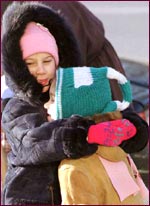 Russia’s
total population in 2001 was estimated at 147,501,000, making
the country the sixth most populous, after China, India,
the United States, Indonesia, and Brazil. Russia’s
total population in 2001 was estimated at 147,501,000, making
the country the sixth most populous, after China, India,
the United States, Indonesia, and Brazil.
Since the dissolution of the Soviet Union the number
of immigrants to Russia has exceeded the number of Russians
leaving the country. Despite the significant influx of ethnic
Russians from neighboring republics during the early to mid-1990s,
over the past nine years Russia’s population has shrunk
by over 3 million people. Population forecasts are even
grimmer. The rate of natural increase (the number of births
compared to the number of deaths) has been negative since 1992.
In 2001 the birth rate was 9.3 per 1,000, while the death rate
was 13.8 per 1,000. 49.
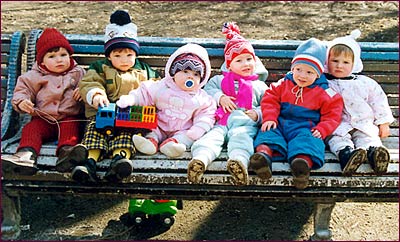 |
Russia displays the greatest ethnic diversity, with censuses
recognizing more than 70 distinct nationalities. Many
of these are extremely small - in some cases consisting of only
a few thousand individuals - and, in addition to Russians, only
a handful of groups have more than a million members each: Tatars,
Ukrainians, Chuvash, Bashkir, Belarusians, and Mordvins. Russians,
the overwhelming majority, constitute about four-fifths of the
total.

|
|
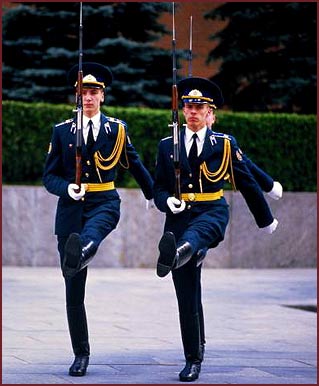 Moscow, Red Square, guards outside
Lenin's Mausoleum.
Moscow, Red Square, guards outside
Lenin's Mausoleum. |

|
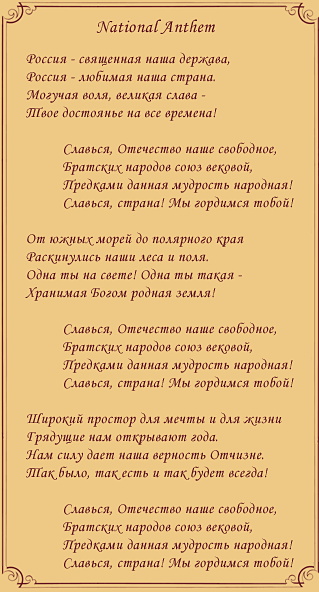
 Click
here to listen Russian National Anthem. Click
here to listen Russian National Anthem. |

|
Economy
and Organized Crime
Russia continues to experience formidable difficulties
in moving from its old centrally planned economy to a modern
market economy.
Economic situation in Russia has deteriorated since the
beginning of Gorbachev's Perestroika.
President Yeltsin's government has made substantial strides
in converting to a market economy since launching its economic
reform program in January 1992 by freeing nearly all prices,
slashing defense spending, eliminating the old centralized distribution
system, completing an ambitious privatization program, establishing
private financial institutions, and decentralizing foreign trade.
|
Russia, however, has made
little progress in a number of key areas that are needed to
provide a solid foundation for the transition to a market economy.
Financial stabilization has remained elusive, with wide swings
in monthly inflation rates. In addition, Moscow has yet to develop
a social safety net that would allow faster restructuring by
relieving enterprises of the burden of providing social benefits
for their workers and has been slow to develop the legal framework
necessary to fully support a market economy and to encourage
foreign investment. As a result, output has continued to fall.
Russia achieved a slight recovery in 1997, but the government's
stubborn budget deficits and the country's poor business climate
made it vulnerable when the global financial crisis swept through
in 1998. The crisis culminated in the August depreciation of
the ruble, a debt default by the government, and a sharp deterioration
in living standards for most of the population. The exchange
rate of US Dollar flew up from 6 to 24 rubles in less than 6
weeks. Small businesses were almost devastated. Prices
for consumer goods increased in 4-5 times with the salaries
increased only on 20-30%.
The economy rebounded in 1999 and 2000, buoyed by the
competitive boost from the weak ruble and a surging trade surplus
fueled by rising world oil prices. This recovery, along with
a renewed government effort in 2000 to advance lagging structural
reforms, have raised business and investor confidence over Russia's
prospects in its second decade of transition. Yet serious problems
persist. Russia remains heavily dependent on exports of commodities,
particularly oil, natural gas, metals, and timber, which account
for over 80% of exports, leaving the country vulnerable to swings
in world prices. Russia's agricultural sector remains beset
by uncertainty over land ownership rights, which has discouraged
needed investment and restructuring. Another threat is negative
demographic trends, fueled by low birth rates and a deteriorating
health situation - including an alarming rise in AIDS cases
- that have contributed to a nearly 2% drop in the population
since 1992. Russia's industrial base is increasingly dilapidated
and must be replaced or modernized if the country is to achieve
sustainable economic growth.

Typical Russian house in the suburbs.
|
The government experiences
permanent difficulties with collection of taxes and fulfilling
the national budget. Frequent changes of prime-ministers and
government during the last 1,5 years left the country out of
control. A lot of economic activity is officially unaccounted
for and organized crime plays a significant role. Other problems
include widespread corruption, capital flight, and brain drain.
 Having
your own business in Russia is a big challenge. The tax system
works in the way that if one has a small business (individual
private enterprise), he must estimate his future income, and
pre-pay taxes proceeding from the assumption. Then he gets a
permission to start his business activity; but he must run to
the tax department the second he earns 1 Ruble more profit than
it was estimated and paid in advance. Otherwise it will be considered
a hidden profit, and one can easily get a fine of the size equal
to 200% of the amount of the hidden profit. The authorities
are suspicious towards owners of small businesses. Having
your own business in Russia is a big challenge. The tax system
works in the way that if one has a small business (individual
private enterprise), he must estimate his future income, and
pre-pay taxes proceeding from the assumption. Then he gets a
permission to start his business activity; but he must run to
the tax department the second he earns 1 Ruble more profit than
it was estimated and paid in advance. Otherwise it will be considered
a hidden profit, and one can easily get a fine of the size equal
to 200% of the amount of the hidden profit. The authorities
are suspicious towards owners of small businesses.
The bigger enterprises have a more convenient tax system.
In 2000 the government announced united tax of 12% on profits,
and even said the hidden (*black*) capitals may be legalized
if the owner pays this 12% tax. At the same time there were
comments from top government officials that this is only a temporary
retreat, and the progressive tax system will be brought back
as soon as people get used to paying their taxes. Actually,
the government hoped that people would start paying tax and
show their real profits - but Russians know their government.
They don't want to be easily trapped by showing off their true
income, and then be obliged to pay again enormous taxes of the
past (up to 90% in different - state, region, city and others
- taxes on profit). Collecting taxes is still the biggest concern
for the Russian government. Most serious investors of so called
"New Russians" transfer their capitals abroad (of
course, it's illegal).
|
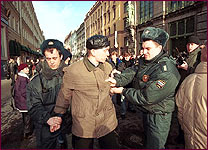 Another
reality businesses face in Russia is organized crime, which
often has close connections with authorities. Small and medium
businesses have to pay about 10% of the profits to "raket".
Nowadays many businesses prefer to employ "commercial"
departments of police organizations or private security companies,
which are in reality just a camouflaged "racket".
They will "help" you in a case of bad debts, problems
with business partners or criminal situations like robbery etc,
providing you a "roof". All "criminal cooperations"
have official businesses registered, and you pay them an official
fee additionally to unofficial. Another
reality businesses face in Russia is organized crime, which
often has close connections with authorities. Small and medium
businesses have to pay about 10% of the profits to "raket".
Nowadays many businesses prefer to employ "commercial"
departments of police organizations or private security companies,
which are in reality just a camouflaged "racket".
They will "help" you in a case of bad debts, problems
with business partners or criminal situations like robbery etc,
providing you a "roof". All "criminal cooperations"
have official businesses registered, and you pay them an official
fee additionally to unofficial.
If you have some problems with your business partner,
your "roof" ("krysha") will meet with the
other guy's "roof", and they will try to settle your
business problems trough mutual discussion. If they can't get
right, they may apply to an unbiased source - a person "in
law" ("v zakone"), who will take a decision,
usually quite just. This decision is final, and you can't apply
against of it, or get rid of it. There is an official way of
settling the problems through a state court, but it's almost
out of use: it's long, unpredictable and rather pathetic. |

|
Links
To read the news from Russia check out www.dni.ru,
www.1tv.ru,
official russia
(russian only) or russiapolitical.com
www.english.pravda.ru
www.russiajournal.com
(english) websites.
To visit website ot the Consulate General Of The Russian
Federation in Toronto please click
here.
Few more interesting websites about Russian culture,
news and travel - face
of russia, radio
voice of russia, gotorussia.net,
russian
journal (Russian only), interesting article on how
to do business in Russia, www.russiananalitica.com
To learn about Russian lifestyle click
here.
|
|



